After giving birth, any mother strives to quickly return her figure to its former beauty. Along with a healthy diet, women resort to exercise, including swimming and high-impact water aerobics - a type of water gymnastics. Meanwhile, many mothers are not sure whether it is even possible to swim in the pool in the first months after childbirth. In this article we will summarize the advice of doctors regarding water exercises during breastfeeding after natural birth and cesarean section.
Benefits of exercising in water
In an aquatic environment, any exercise is easier than “on land”, while surpassing the latter in effectiveness.
The ease of exercise is due to the fact that in water a person is in a state close to weightlessness, and the water pressure simultaneously stimulates blood circulation in the body, which significantly increases the effectiveness of training.
The thermoregulation of the human body also plays into its hands: in relatively cool water, the body is forced to warm up, using up its fat reserves.
Another pleasant and important bonus is the psychological mood. If in the gym many mothers after giving birth are ashamed of their far from ideal figure, then in the pool most of the shortcomings are almost invisible. As a result, the woman trains better.
In addition to successfully burning fat, water aerobics and swimming strengthen the back muscles (the muscles of which are subject to severe stretching during pregnancy), preventing scoliosis, osteochondrosis and other diseases of the musculoskeletal system. Also, exercise in water restores the immune system and effectively eliminates postpartum depression.
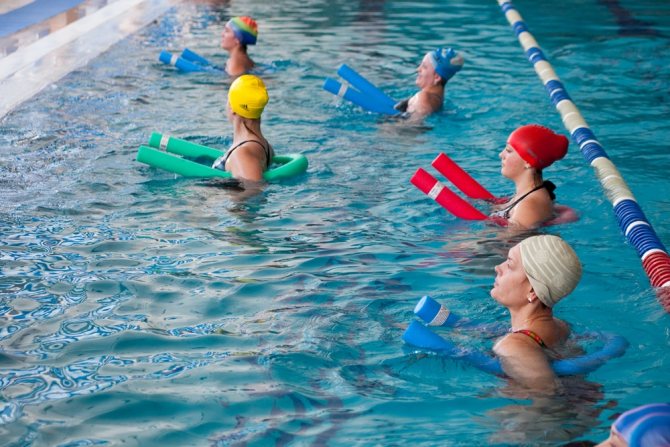
Due to its low-impact nature, water gymnastics is considered the most suitable sport for mothers during breastfeeding. This, however, does not eliminate the need to take some precautions. So, in pursuit of a quick effect, you cannot get carried away and perform too many exercises, so as not to cause overstrain of unprepared muscles.
When can you start training?
According to gynecologists, mothers can start visiting the pool no earlier than three months after giving birth. If the mother has undergone a cesarean section or episiotomy, she will have to forget about water aerobics until full recovery (at least 6 months and personal permission from the attending physician).
In the first days of training, it is necessary to limit yourself to minimal loads, increasing them over time under the supervision of an instructor. Excessive load in the first classes can result in damage to the ligaments. To begin with, all you need to do in the pool is walk and swim slowly. These extraordinary exercises are designed to prepare muscles and ligaments for more serious loads and prevent injuries.
An important point: during breastfeeding, loading the shoulder girdle should be avoided. Involvement of the muscles of the shoulders, chest and arms can disrupt lactation, leading to excess lactic acid in the milk. This in turn can cause the baby to refuse milk.
At the first stage, women need to work on the muscles of the legs, abs and lower back. Later, with the permission of the instructor, you can increase the load and diversify these exercises with new ones.
The duration of the first workouts after childbirth should not be more than half an hour. After 3-4 visits to the pool, the class time can be increased by 15 minutes, then by another 15 minutes. If the mother practiced water exercises during pregnancy, and her muscles are already prepared, the increase in load can be accelerated within reasonable limits.
Features of swimming while breastfeeding
There is a widespread belief that it is better for a nursing mother not to go to the pool at all. Women are concerned that contact of the breasts with chlorinated water may affect the quality of milk or cause painful irritation. Doctors refute these claims - penetration of water into the milk ducts is impossible, and the skin will be protected by a cream with a high percentage of fat content, which must be applied at least half an hour before class. But swimming in the pool during breastfeeding can be dangerous for other reasons:
- hypothermia - the body is weakened after childbirth, so there is a high probability of exacerbation of chronic diseases and viral infection;
- milk rushes - during training it is impossible to feed on time, which leads to lactostasis and a high likelihood of developing an infection;
- high loads on the chest muscles - can interfere with the establishment of lactation, increase the amount of lactic acid, which will lead to the baby refusing milk;
- inflammation of nipple cracks - getting chlorinated water into the wounds can cause irritation and delay the healing process.
Improving training efficiency
With the consent of the instructor, it is not only possible, but also advisable to swim with special devices in order to intensify training and achieve the desired figure after childbirth in the shortest possible time.
There are five most popular devices for water gymnastics:
- Shoes for running on the bottom. Its goal is to increase the load on the muscles of the buttocks, thighs and legs. Running underwater is one of the best exercises for losing excess weight after childbirth, especially since you can start practicing it from the very first visit to the pool.
- Aqua cuffs. Designed to work the leg muscles by increasing the load on them. Typically made from EVA (polyethylene foam) material and may have a sand filling that allows the weight of the cuffs to be adjusted as needed
- Neoprene gloves. This accessory is necessary to increase the load on the arm muscles. Thanks to the membranes, the shape of the gloves resembles frog legs, which provides high water resistance.
- Support belt. Allows you to perform exercises without your feet touching the bottom of the pool, which creates a load on all muscle groups. Used at a depth of at least one and a half meters and only by women with good physical fitness.
- Noodle. A device in the form of a flexible pole made of the same EVA, which has good buoyancy. Like a belt, it is designed to keep a person afloat, thereby developing balance and loading all muscle groups. The advantages of the noodle are the ability to be used at shallow depths.
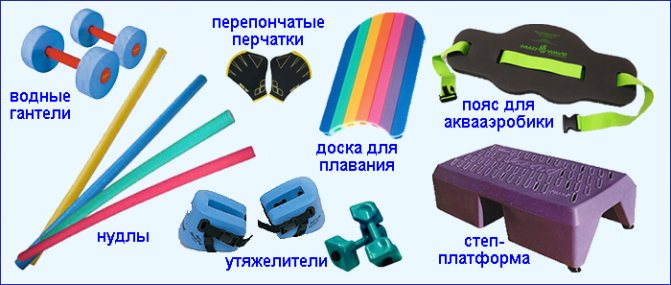
Highly effective exercises for training in water
- Swing your legs. Starting position: arms extended to the sides, legs straight. The exercise consists of alternately raising your legs up as high as possible. For the first time, there are 15 swings on each leg; subsequently, the load should be increased with each session. When performing swings, you need to keep your back straight and your knees not bent. Otherwise, the exercise will not bring the expected result.
- Skier's steps. Starting position: feet shoulder-width apart, arms extended down. It is necessary to walk along the bottom, imitating the movements of a skier. The front leg is slightly bent when walking, the back leg remains straight. In movement you need to help yourself with your hands. In the first lesson, it is enough to take 15 steps on each leg; in subsequent lessons you can increase the number of steps.
- Underwater running. The depth required to perform the exercise is shoulder-deep or waist-deep. The back should be straight, the stomach should be retracted. The exercise consists of running in place. Your knees should be raised as high as possible, actually touching your chest. In this case, you need to pull your toes up, and with your arms bent at the elbows you can help yourself raise your legs. Starting with 15 lifts of each leg, in future classes their number must be increased.
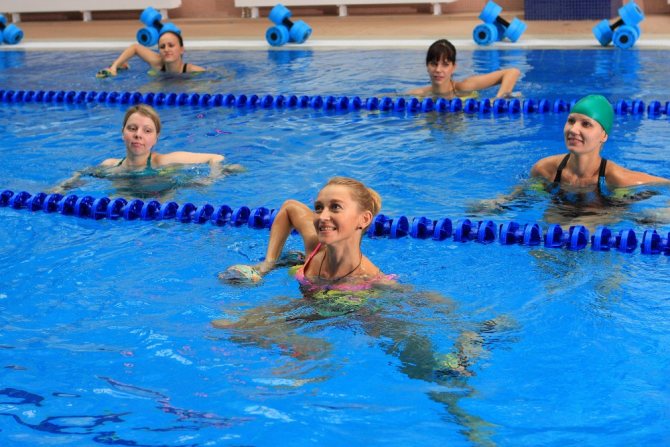
The above set of exercises is basic and can be performed by any mother after childbirth. A trainer can and should select an individual set of exercises for each woman in accordance with her needs and physical capabilities.
New life - new swimsuit
When you can swim in the pool after a long period of inactivity, a burning question arises for a woman: what to wear? The figure has become not entirely familiar, features have arisen that you can no longer proudly boast to others about, and adjustments are needed somewhere. How to approach this problem correctly so that you are both beautiful and healthy at the same time? Here are tips that can help you become irresistible.
Changes in breast volume
- The swimsuit can be one-piece, combined or separate. If the bottom and top are strikingly different in size, you should choose a separate one and combine the necessary parameters. The emphasis in this case is on the chest, so they are not particularly worthy of attention.
- The top should have wide straps and padded cups.
- A halter (a type of swimsuit with straps that tie at the neck) is the best option: it supports, lifts, and fixes the breasts. It’s better not to take risks without straps if you’re not a fan of unexpected endings (literally and figuratively).
- Separate sets will be good with a halter top, and the bottom can be a bikini, tanga, slip - depending on your figure and courage.
- Combined swimsuits give complete freedom of imagination - combine what and how you want, buying parts separately.
Read also: Modern types of contraceptives for women after childbirth
Emphasis on the abdomen (enlarged, there are scars or stretch marks)
- The best option is a monokini. Is it possible to remain sexy after childbirth? With him it’s possible. Very feminine, will provide attention from men and excellent well-being. The back will become an area of increased attention, and the tummy will modestly hide behind a connective strip of tissue. The decor can be anything.

- Plunge - closed, with a deep neckline, exaggerated edits. The neckline will focus the attention of those interested on the chest and décolleté, delicately hiding scars from view.
- Do you like separate ones? Opt for high-top swim trunks that will tighten your belly.
- Tankini - if you need to hide a lot. The top and swimming trunks included will give you a feeling of security.
Increased total weight, dimensions
- Tankini or one-piece are the right models. The back is open, problem areas are hidden from prying eyes. And, of course, a deep neckline.
- There are models of one-piece swimsuits with corrective inserts - pay attention to them.
- A pattern can visually elongate a figure: vertical stripes, patterns and patterns that influence the overall image.
- If you like monochromatic models, choose dark tones.
- If you like multi-colored ones, stop at two-color ones. Combine dark with light, hiding and highlighting the desired areas accordingly. Dark colors will make problem areas less noticeable, but light colors will draw attention to what you can really show off.
- Massive hips will be hidden by a suit - a swimsuit and a dress at the same time.
Colors and accessories are additional ways to manipulate how your figure is perceived. A tunic, pareo, and skirts will add color and mood.
Going to the pool with your child
It is becoming increasingly fashionable to attend water aerobics sessions with infants. Pediatricians are confident that the aquatic environment is more natural for a small child, and water activities:
- normalize the hormonal levels of the baby;
- have a beneficial effect on the nervous system;
- promote psychomotor development;
- form motor skills;
- increase lung capacity;
- enrich the blood with oxygen;
- in lethargic and weakened children, they stimulate the development of reflexes;
- relieves tension in tense children;
- train the heart;
- strengthen the immune system;
- develop flexibility, endurance, agility and strength;
- provide good posture;
- accelerate the development of the child;
- charged with positive emotions.
It has long been noticed: when children regularly attend such procedures, they are ahead of their peers in physical development, begin to walk earlier, become more active and get sick much less often.
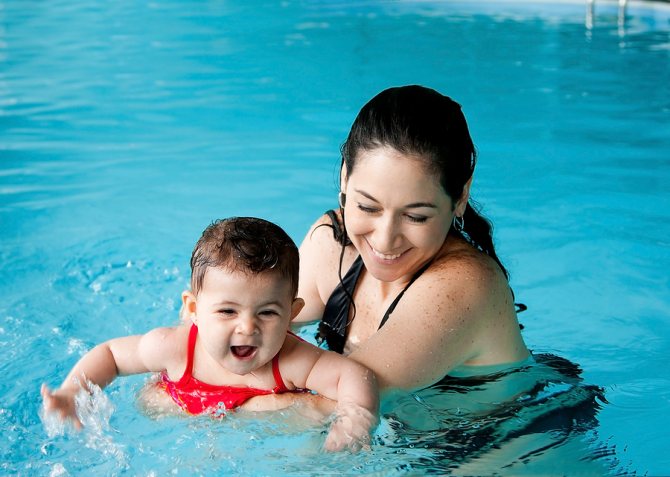
However, you can go to water aerobics with your baby only with the approval of your pediatrician. Even the choice of the pool itself matters. It is necessary to familiarize yourself with the sanitary standards and rules governing the construction of swimming pools. It is preferable to choose a sports complex where mineral water is used instead of chlorinated water. If you are going to swim in chlorinated water, you should definitely make sure that the mass fraction of chlorine or other disinfectants does not exceed the norm, otherwise there is a possibility of harming the baby’s health.
Before signing up for water aerobics, the mother needs to obtain a certificate from the therapist confirming that she and her child are healthy. For water aerobics, the usual set of things used in the pool is suitable.
After how many months can you take your child with you?
In the absence of serious contraindications from the pediatrician, you can go to water aerobics with your child six months after giving birth. Groups are created especially for joint activities between nursing mothers and children, the exercises in which are selected taking into account the capabilities of the infant body.
How to feed a child in class
Although in sports complexes, the pools of which are designed for joint activities of women and infants, special hygiene measures are observed, it would not be superfluous for the mother to adhere to several simple rules during feeding:
- Before feeding, you should wash your breasts in the shower.
- You cannot feed your baby directly in the water.
- It is not advisable to feed your baby tightly.
- You must bring a bottle of baby water with you to class.
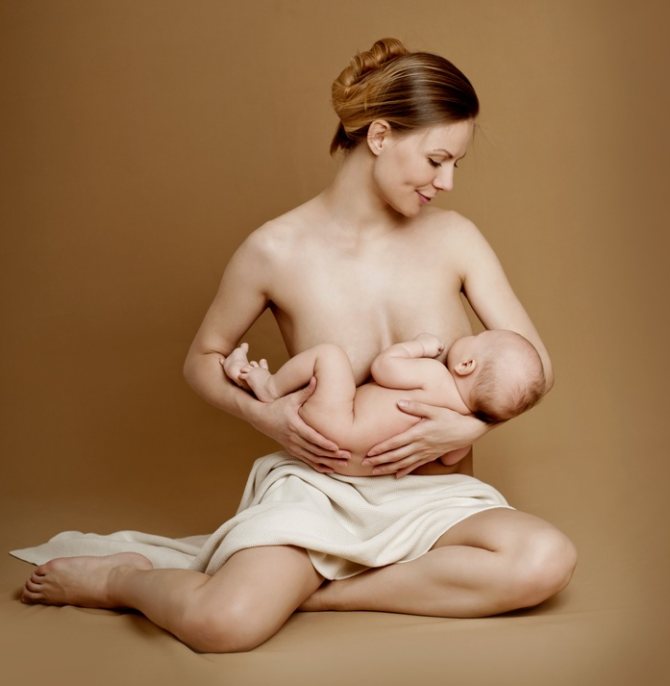
Water aerobics is the best choice for mothers who want to quickly regain their previous figure and restore muscle tone. A healthy woman can start swimming and exercising in the pool 3 months after giving birth. In the sixth month, you can accustom your child to water procedures. Water aerobics will have a beneficial effect on the speed of its development, strengthen the immune system and give a lot of positive impressions. However, it is important to remember that pools designed for activities with children must strictly comply with sanitary standards. It is also not allowed to attend such classes without authorization without the approval of the pediatrician.
372
What you need to attend water procedures
Before enrolling in a water aerobics group, you must obtain a certificate from your therapist that you and your child are healthy. To classes you must take with you a standard set of things needed in the pool.
Scientists have long proven that water is a natural environment for a newborn baby; it has a beneficial effect on the child’s body. Exercising in water has a beneficial effect on the nervous system, physical development and improves immunity. Children who visit the pool very soon begin to outstrip their peers in development, they get sick less and grow up more active than other children.










